#kinetic installation
Explore tagged Tumblr posts
Text

"SORA v.1" by NONOTAK in Amsterdam w/Unfold Art.
#nonotak#amsterdam#visualart#immersive#takami nakamoto#noemi schipfer#nonotak studio#kinetic#kinetic installation#kinectart#kinecticart#installation art#art installation
10 notes
·
View notes
Text
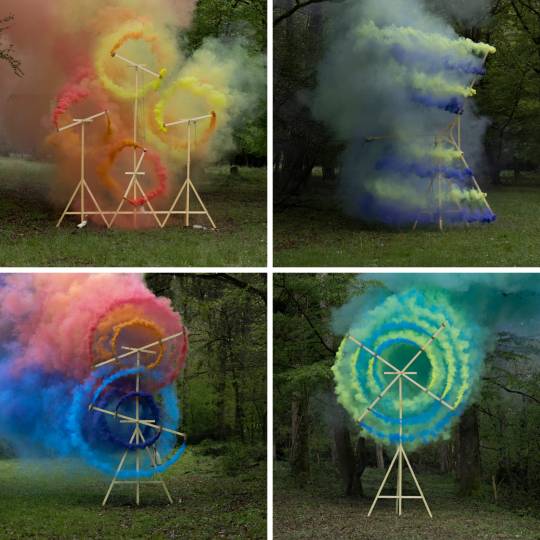
Site-Specific Kinetic Installations by Pinaffo & Pluvinage Channel Modest Materials Into Ephemeral Experiences
222 notes
·
View notes
Photo
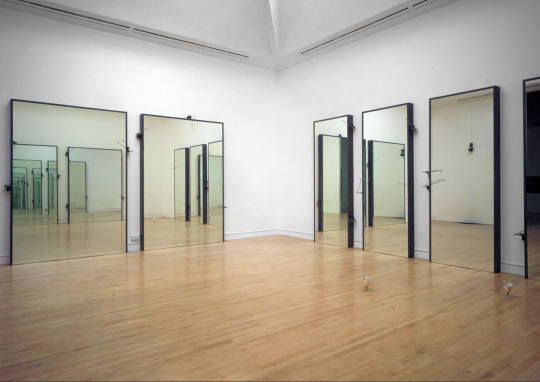
Rebecca Horn, Ballet of the Woodpeckers, 1986, glass, metal, transformers, motors and egg
297 notes
·
View notes
Text
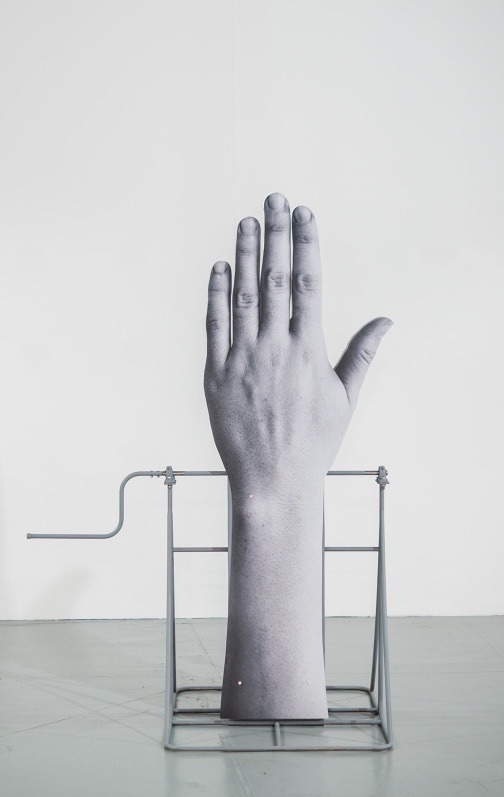
Lucy Gregory - TheApplause Machine, 2019
100 x 150 x 220cm
#Kinetic Sculpture#Steel#fixings#paint#digital printing#aluminium#lucy gregory#art#artist#contemporary art#sculpture#installation#object#exhibition
34 notes
·
View notes
Text

Magdalena Fernández, Flexible Structures, (video), Sicardi | Ayers | Bacino, Houston, TX, 2017 [© Magdalena Fernández]



#art#kinetic art#arte cinetica#arte programmata#installation#sculpture#structure#geometry#magdalena fernández#sicardi ayers bacino#2010s
11 notes
·
View notes
Text
#ja.ko.mo#failure#2024#art#installation#kinetic#contemporaryart#kineticsculpture#kineticart#woodworking#nail#hammer#craft#nailed
4 notes
·
View notes
Text

Check out the video at the link below. It’s of a kinetic art piece “Strandbeest” - by Dutch Theo Jansen. The creation is 59 feet long and scuttles across a beach using the power of the wind. It looks alive and magical. Recommend sound on (no narration, just the sound of the shore).
youtube


@itscolossal
#art installation#theo jansen#kinetic art#wind powered#beach#Dutch#Strandbeest#video link#animaris Rex#Youtube
10 notes
·
View notes
Text
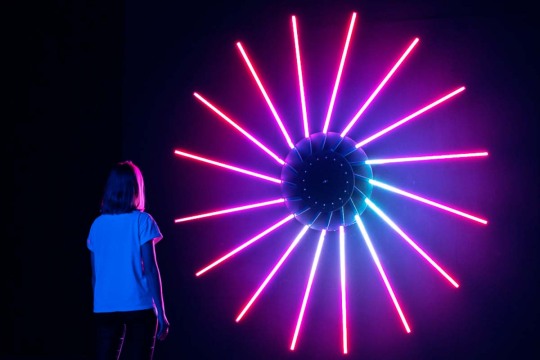
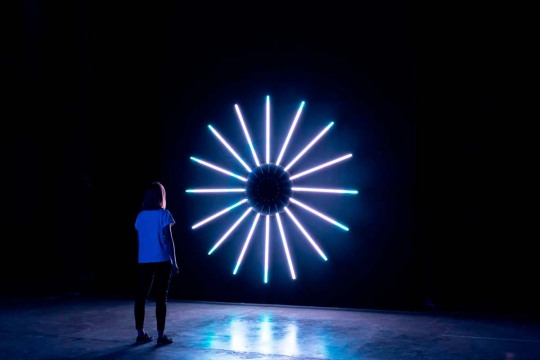
The installation "Pause" invites the viewer to reflect on the passage of time and find tranquility in the present moment
Music by Digital Moss
#kinetic art#lightart#ledinstallation#light installation#digitalart#immersive art#parametricdesign#newmediaart
9 notes
·
View notes
Text
@falling-down-the-scroll-hole, I saw this and thought of you.
3 notes
·
View notes
Text

Velvet underground
#underground#snacktime#love seats#bahn#unintentional installation art#about last night#sound art#environment art#art#fine arts#concept art#art gallery#contemporary sculpture#contemporary art#performance art#kinetic art
2 notes
·
View notes
Text

Monumental Site-Specific Installations by Morag Myerscough Stoke Community and a Sense of Belonging
78 notes
·
View notes
Photo

Rebecca Horn, Cutting Through the Past, 1992-93, 5 doors, metal shaft, motor
#rebecca horn#art#installation#We were in the gold room where everyone finally gets what they want#contemporary art#objects#doors#built space#kinetic sculpture
71 notes
·
View notes
Photo

“Chroma V” (2022), acrylic, aluminum, polymer, LED, motor, and microcontroller, 235 x 800 x 225 centimeters
Lively Kinetic Sculptures by Yunchul Kim Pulse with Iridescent Color-Changing Cells
Seoul-based artist Yunchul Kim echoes the heaving, lively motion of breath in his glimmering kinetic sculptures. Part of the ongoing Chroma series, the mixed-media works are reactive: small motors bend the transparent polymer material and cause an iridescent, color-changing ripple that pulses across the piece. Often suspended in a gallery space, the sculptures are knotted or shaped like a vortex, as in “Chroma V,” which references “subjects and symbols of culture and disciplines, such as ancient murals, nature, literature, art, philosophy, and science,” Kim says.

“Chroma V” (2022), acrylic, aluminum, polymer, LED, motor, and microcontroller, 235 x 800 x 225 centimeters. Photo by Roman März

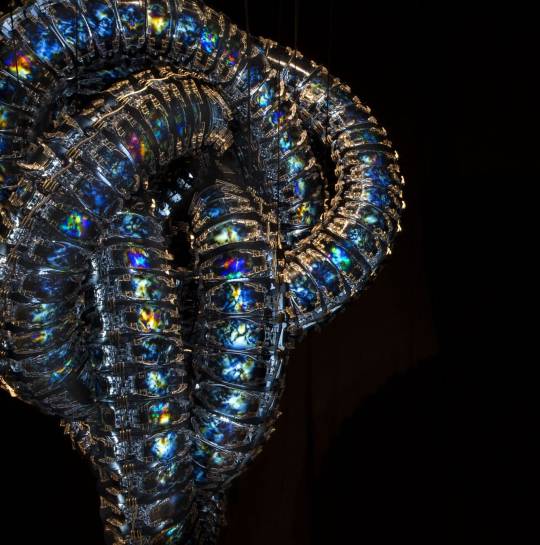
#yunchul kim#artist#kinetic sculptures#sculptures#art#iridescent color-changing cells#seoul-based artist#chroma series#mixed media work#transparent polymer material#public art installation#roman marz#photographer
5 notes
·
View notes
Text

Ulf Rollof
1 note
·
View note
Text
A few other ‘Isms’ not to be left unmentioned - An ‘Ism’ Overview - Perspectives Comparing And contrasting art movements
The significance of Prehistoric Art, Medieval Art, Neoclassicism, Bauhaus, Kinetic Art, Digital Art, Installation Art, Digital Circles, and Lowbrow Art, in the evolution of art cannot be overstated. These movements and styles, spanning from the ancient to the contemporary, have all made important contributions to the development of art, each in their unique ways.
Let us begin with prehistoric art. Although the earliest examples of human artistic expression date back over 40,000 years, prehistoric art has often been dismissed as primitive or unsophisticated. However, I argue that these works represent some of the most powerful and enduring expressions of human creativity. From the intricate cave paintings at Lascaux and Altamira to the iconic Venus figurines, prehistoric art speaks to the fundamental human desire to create, to communicate, and to explore our world. By studying these works, we gain insight into the early development of human culture and consciousness, and we gain a deeper appreciation for the universality of the creative impulse.
Medieval art, which spanned from the 5th to the 15th century, was heavily influenced by Christianity and often depicted religious subjects in a stylized and symbolic way. Medieval art also drew on classical Greek and Roman styles, and was characterized by bright colours, gold leaf, and intricate patterns. Examples of medieval art include the Book of Kells (c. 800) and the Bayeux Tapestry (c. 1070).
Neoclassicism emerged in the mid-18th century as a reaction against the ornate and frivolous Rococo style that dominated European art. Neoclassical artists looked to the art of ancient Greece and Rome for inspiration, seeking to capture the ideals of rationality, balance, and order that were associated with classical art. Neoclassicism reached its peak in the late 18th and early 19th centuries, with artists such as Jacques-Louis David, Jean-Auguste-Dominique Ingres, and Antonio Canova creating works that exemplified the style's emphasis on classical subject matter and classical forms. David's "The Death of Marat" (1793) and Ingres' "La Grande Odalisque" (1814) are two examples of Neoclassical works that continue to be celebrated for their technical mastery and emotional impact.
The Bauhaus was a German art and design school that was active from 1919 to 1933. Founded by Walter Gropius, the Bauhaus was dedicated to the idea of merging art and technology, with the goal of creating functional, modern designs that could be mass-produced. The Bauhaus attracted some of the most innovative artists and designers of the early 20th century, including Paul Klee, Wassily Kandinsky, and Marcel Breuer. These artists experimented with new materials and techniques, creating furniture, textiles, and buildings that were characterized by their sleek, geometric forms and minimal ornamentation. The Bauhaus's legacy can be seen in the many modernist designs that continue to influence contemporary architecture and design.
Kinetic art emerged in the 1950s and 60s as a response to the growing interest in science and technology. Kinetic artists sought to create works that would move or change in response to the viewer's actions or the environment in which they were placed. Artists such as Alexander Calder, Jean Tinguely, and George Rickey created sculptures that moved in response to the wind or other external forces, while others, such as Nam June Paik and Bill Viola, incorporated technology such as video and sound into their works. Kinetic art challenged traditional notions of sculpture as static and unchanging, and continues to be an important influence on contemporary sculpture and installation art.
Installation art emerged in the 1960s as a response to the increasing commercialization of art and the growing emphasis on the art object as a commodity. Installation artists sought to create immersive, site-specific experiences that would challenge the viewer's perceptions of space, time, and reality. Artists such as Claes Oldenburg, Robert Irwin, and Dan Flavin created works that transformed entire rooms or environments, using light, sound, and other sensory stimuli to create a fully immersive experience. Installation art continues to be a popular form of contemporary art, with artists such as Olafur Eliasson, Yayoi Kusama, and Ai Weiwei pushing the boundaries of what is possible in the medium.
Let’s rest for a longer moment to unpack the explosive significance of this next art movement. As a champion of high modernism and a staunch defender of the avant-garde, I must admit that the rise of Lowbrow Art has taken me somewhat by surprise. For years, I believed that the only meaningful art was that which challenged the viewer and pushed the boundaries of aesthetic experience. However, the emergence of Lowbrow Art in the late 20th century has forced me to reconsider my assumptions and to recognize the value of a different kind of artistic expression.
Lowbrow Art, also known as pop surrealism or underground art, has its roots in the countercultural movements of the 1960s and 1970s. It emerged as a reaction against the hegemony of the mainstream art world, which was dominated by the formalist and minimalist tendencies of high modernism. Lowbrow artists rejected the elitism and austerity of modernism, and instead embraced a wide range of popular cultural forms, from comic books and sci-fi movies to street art and tattooing.
One of the earliest pioneers of Lowbrow Art was the American artist Robert Williams. In the late 1960s, Williams began creating vivid and often provocative paintings that combined elements of pop culture with traditional techniques of oil painting. His work was characterized by its irreverent humor, graphic violence, and sexual imagery, and it quickly gained a following among underground artists and collectors. Other key figures in the development of Lowbrow Art include Mark Ryden, Todd Schorr, and Camille Rose Garcia, all of whom have continued to push the boundaries of the genre in recent years.
One of the most significant aspects of Lowbrow Art is its engagement with popular culture and its ability to tap into the zeitgeist of contemporary society. Whereas high modernism sought to transcend the constraints of mass culture, Lowbrow Art celebrates and critiques it, using its imagery and iconography as a means of exploring broader cultural issues. This is evident in the work of artists like Ron English, whose subversive billboard campaigns have commented on everything from fast food to the Iraq War, and Shepard Fairey, whose iconic "Hope" poster for Barack Obama's 2008 presidential campaign became an instant cultural phenomenon.
Another important aspect of Lowbrow Art is its technical virtuosity and attention to detail. Although it often draws on the conventions of popular culture, Lowbrow Art is also deeply rooted in the traditions of fine art, and many of its practitioners are highly skilled in traditional techniques such as painting, drawing, and printmaking. This can be seen in the work of artists like Audrey Kawasaki, whose ethereal, dreamlike paintings combine elements of Japanese anime with the delicacy and precision of traditional Japanese art, and James Jean, whose intricate and highly detailed illustrations have earned him comparisons to the Old Masters.
Of course, as with any artistic movement, there are those who dismiss Lowbrow Art as mere kitsch or commercialism. However, I would argue that this misses the point of what makes the genre so compelling. Lowbrow Art is not simply a celebration of popular culture, nor is it a wholesale rejection of traditional art forms. Rather, it represents a new kind of artistic synthesis, one that draws on a wide range of influences and traditions to create something entirely new and innovative.
In my final analysis, then, Lowbrow Art represents an important and valuable contribution to the world of contemporary art. It is an art that is unafraid to challenge the status quo and to embrace the full range of human experience, from the sublime to the grotesque. And while it may not be to everyone's taste, it is an art that demands to be taken seriously and that deserves to be celebrated for its technical skill, cultural relevance, and sheer audacity.
Moving forward in time, we come to the realm of digital art. Unlike prehistoric art, which was created using natural materials and simple tools, digital art relies on sophisticated technologies and computer software. Since the advent of digital art in the 1960s, artists have been using computers to create new forms of visual expression, from pixelated landscapes to immersive virtual environments. Digital art allows artists to explore new aesthetic possibilities, to push the boundaries of traditional media, and to engage with the complex relationship between technology and culture.
Within the realm of digital art, we find the emergence of digital circles - groups of artists and designers who collaborate and share their work online. These communities allow for the rapid dissemination of new techniques, ideas, and styles, and they encourage a spirit of experimentation and innovation. Some notable examples of digital circles include the net.art movement of the 1990s, the Glitch Art movement of the 2000s, and the current wave of NFT artists.
#art#artwork#learning#teaching#art process#creativity#inspiration#education#art education#art history#20th century art#art critique#art movements#digital art#prehistoric art#medieval art#neoclassism#bauhaus#kinetic art#installation art#digital circles#lowbrowart
1 note
·
View note
